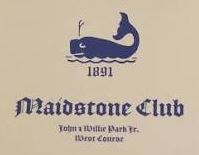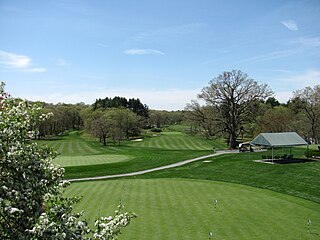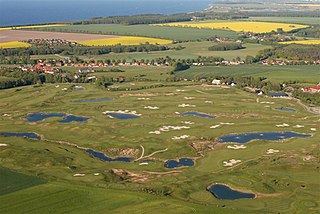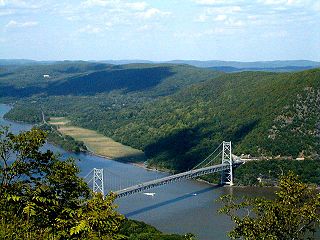
Oak Hill Country Club is a country club located in Pittsford, New York, a suburb southeast of Rochester. Founded in 1901 and best known for its golf course, the club has hosted multiple major championships.

The Westchester Country Club was founded in 1922 by John McEntee Bowman, who hired Walter Travis to design two golf courses in the Town of Harrison, New York, as a luxury resort hotel.

Winged Foot Golf Club is a private club with two 18-hole golf courses located in Mamaroneck, New York. The course architect is A. W. Tillinghast, who also designed Baltusrol (Lower), Bethpage Black, Suburban Golf Club, Shackamaxon Country Club, Oak Hills Country Club in San Antonio, San Francisco Golf Club, Cedar Crest Park, and nearby Quaker Ridge Golf Club, Scarboro Golf and Country Club in Toronto and Wykagyl Country Club. Winged Foot Golf Club was founded in 1921, by a consortium consisting mainly of members of The New York Athletic Club. The club gets its name and logo from the NYAC's logo, but the two have never had any direct affiliation. Winged Foot G.C. opened in June 1923. Application for membership is by invitation only.

The Philadelphia Cricket Club, founded in 1854, is the oldest country club in the United States. It has two locations: Chestnut Hill, Philadelphia, and Flourtown, Pennsylvania.
Pittsburgh Field Club is a private country club, established in 1882, located six miles (10 km) northeast of downtown Pittsburgh in the suburb of Fox Chapel, Pennsylvania. It rounds out an impressive quartet of courses in the suburbs northeast of Pittsburgh, along with the Longue Vue Club, Oakmont Country Club and the Seth Raynor-designed Fox Chapel Golf Club.

The Maidstone Club is a private country club on the Atlantic Ocean in the village of East Hampton, New York. Maidstone has both an 18-hole and 9-hole private golf course.
Barsebäck Golf & Country Club is a golf club located in Barsebäck, in the northern part of Metropolitan Malmö in the province of Skåne in southern Sweden, just by the Öresund strait.

Charles Blair Macdonald was a major figure in early American golf. He built the first 18-hole course in the United States, was a driving force in the founding of the United States Golf Association, won the first U.S. Amateur championship, and later built some of the most influential golf courses in the United States, to the extent that he is considered the father of American golf course architecture. He is a member of the World Golf Hall of Fame.
Wykagyl Country Club is a golf course in the Wykagyl section of New Rochelle, New York. Through the years, the club has hosted major professional and amateur tournaments and is considered to be one of the premier "classic courses" in the country.

Brae Burn Country Club is a golf course located in West Newton, Massachusetts. Designed by Donald Ross, Brae Burn has hosted seven USGA Championships, including the 1919 U.S. Open, and 1928 U.S. Amateur. Brae Burn is most noted for its diabolical greens, and classic layout.
National Golf Links of America is a prestigious links-style golf course in Southampton, New York, located on Long Island between Shinnecock Hills Golf Club and Peconic Bay. Though the course is noted for hosting the initial Walker Cup in 1922, which the United States won 8 and 4, it has never hosted a major men's championship. The Walker Cup was again held at National in 2013. The private club has been called "America's snootiest golf course" due to its exclusive nature.
The Garden City Golf Club is a private golf course in Garden City, New York. The club was founded in 1899, and is also known as the "Garden City Men's Club" or simply the "Men's Club" to distinguish it from the Garden City Country Club, and Cherry Valley Club, all of which are located in Garden City, NY. It remains one of the few men-only golf clubs in the United States.
Inwood Country Club is a private club specializing in Golf, Tennis & Beach Club in Inwood, New York, located adjacent to Jamaica Bay and just southeast of John F. Kennedy International Airport.

Lindrick Golf Club is a golf course in South Yorkshire and is also a site of special scientific interest (SSSI). The SSSI covers 22 hectares and was designated for its biological interest. The site was notified in 1987.

North Adams Country Club is a semi-private golf course located in Clarksburg, Massachusetts. The club hosts one of the oldest Invitational Singles Tournaments in New England.
The Whippoorwill Club is a private country club facility near Armonk, New York. In 2010 GOLFWEEK magazine ranked the Whippoorwill golf course as the 73rd best classic course in the United States. The club is not just a golf course and there are a few members who do not golf. For these members there is a swimming pool, tennis courts and paddle ball courts, as well as the traditional club house where lunch and dinner is served.
The Detroit Golf Club is a private golf club located in Detroit, Wayne County, Michigan in the middle of a neighborhood area on north side of the city near the University of Detroit Mercy and Palmer Woods Historic District. Bert Way designed the original 6-hole course, then it gradually improved to 9 holes, and finally Donald Ross built the current 36-hole course. The club grounds crew maintains two courses. The North and the South Course. The head pro is Jon Gates. Detroit Golf Club will host the Rocket Mortgage Classic, a new annual PGA Tour event, starting in 2019.
Bonnie-Briar County Club is an 18-hole golf course and country club located in the Town of Mamaroneck in Westchester County, New York. The course architect was A. W. Tillinghast, one of the most prolific architects in the history of golf, and designer of nearby Southern Westchester courses including Quaker Ridge Golf Club, Wykagyl Country Club and Winged Foot Golf Club. The course design made excellent use of Bonnie Briar's hilly and low wetland areas, surrounding a wooded interior. A.H. Tull, Geoffrey Cornish and Robert Trent also contributed to various aspects of the course layout, drainage, tees, greens and bunkers.

Suburban Golf Club is a private club founded in 1896. The current course was designed by golf course architect A. W. Tillinghast in 1922. Tom Bendelow designed the predecessor 9 hole course in 1896. In 1999, Ron Prichard Full restoration.

Austin Country Club is a private golf club in the southern United States, located in Austin, Texas. Established 120 years ago in 1899, the club moved to its third and present site in 1984, a challenging layout designed by noted course architect Pete Dye.













